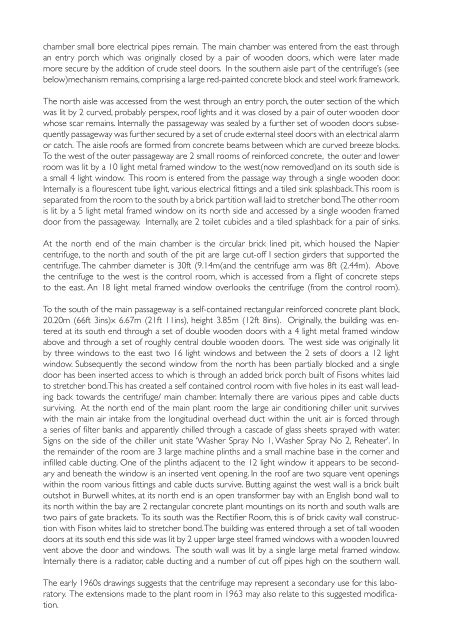Atomic Weapons Research Establishment. Orford ... - English Heritage
Atomic Weapons Research Establishment. Orford ... - English Heritage
Atomic Weapons Research Establishment. Orford ... - English Heritage
Create successful ePaper yourself
Turn your PDF publications into a flip-book with our unique Google optimized e-Paper software.
chamber small bore electrical pipes remain. The main chamber was entered from the east through<br />
an entry porch which was originally closed by a pair of wooden doors, which were later made<br />
more secure by the addition of crude steel doors. In the southern aisle part of the centrifuge’s (see<br />
below)mechanism remains, comprising a large red-painted concrete block and steel work framework.<br />
The north aisle was accessed from the west through an entry porch, the outer section of the which<br />
was lit by 2 curved, probably perspex, roof lights and it was closed by a pair of outer wooden door<br />
whose scar remains. Internally the passageway was sealed by a further set of wooden doors subsequently<br />
passageway was further secured by a set of crude external steel doors with an electrical alarm<br />
or catch. The aisle roofs are formed from concrete beams between which are curved breeze blocks.<br />
To the west of the outer passageway are 2 small rooms of reinforced concrete, the outer and lower<br />
room was lit by a 10 light metal framed window to the west(now removed)and on its south side is<br />
a small 4 light window. This room is entered from the passage way through a single wooden door.<br />
Internally is a flourescent tube light, various electrical fittings and a tiled sink splashback. This room is<br />
separated from the room to the south by a brick partition wall laid to stretcher bond. The other room<br />
is lit by a 5 light metal framed window on its north side and accessed by a single wooden framed<br />
door from the passageway. Internally, are 2 toilet cubicles and a tiled splashback for a pair of sinks.<br />
At the north end of the main chamber is the circular brick lined pit, which housed the Napier<br />
centrifuge, to the north and south of the pit are large cut-off I section girders that supported the<br />
centrifuge. The cahmber diameter is 30ft (9.14m(and the centrifuge arm was 8ft (2.44m). Above<br />
the centrifuge to the west is the control room, which is accessed from a flight of concrete steps<br />
to the east. An 18 light metal framed window overlooks the centrifuge (from the control room).<br />
To the south of the main passageway is a self-contained rectangular reinforced concrete plant block,<br />
20.20m (66ft 3ins)x 6.67m (21ft 11ins), height 3.85m (12ft 8ins). Originally, the building was entered<br />
at its south end through a set of double wooden doors with a 4 light metal framed window<br />
above and through a set of roughly central double wooden doors. The west side was originally lit<br />
by three windows to the east two 16 light windows and between the 2 sets of doors a 12 light<br />
window. Subsequently the second window from the north has been partially blocked and a single<br />
door has been inserted access to which is through an added brick porch built of Fisons whites laid<br />
to stretcher bond. This has created a self contained control room with five holes in its east wall leading<br />
back towards the centrifuge/ main chamber. Internally there are various pipes and cable ducts<br />
surviving. At the north end of the main plant room the large air conditioning chiller unit survives<br />
with the main air intake from the longitudinal overhead duct within the unit air is forced through<br />
a series of filter banks and apparently chilled through a cascade of glass sheets sprayed with water.<br />
Signs on the side of the chiller unit state ‘Washer Spray No 1, Washer Spray No 2, Reheater’. In<br />
the remainder of the room are 3 large machine plinths and a small machine base in the corner and<br />
infilled cable ducting. One of the plinths adjacent to the 12 light window it appears to be secondary<br />
and beneath the window is an inserted vent opening. In the roof are two square vent openings<br />
within the room various fittings and cable ducts survive. Butting against the west wall is a brick built<br />
outshot in Burwell whites, at its north end is an open transformer bay with an <strong>English</strong> bond wall to<br />
its north within the bay are 2 rectangular concrete plant mountings on its north and south walls are<br />
two pairs of gate brackets. To its south was the Rectifier Room, this is of brick cavity wall construction<br />
with Fison whites laid to stretcher bond. The building was entered through a set of tall wooden<br />
doors at its south end this side was lit by 2 upper large steel framed windows with a wooden louvred<br />
vent above the door and windows. The south wall was lit by a single large metal framed window.<br />
Internally there is a radiator, cable ducting and a number of cut off pipes high on the southern wall.<br />
The early 1960s drawings suggests that the centrifuge may represent a secondary use for this laboratory.<br />
The extensions made to the plant room in 1963 may also relate to this suggested modification.

















